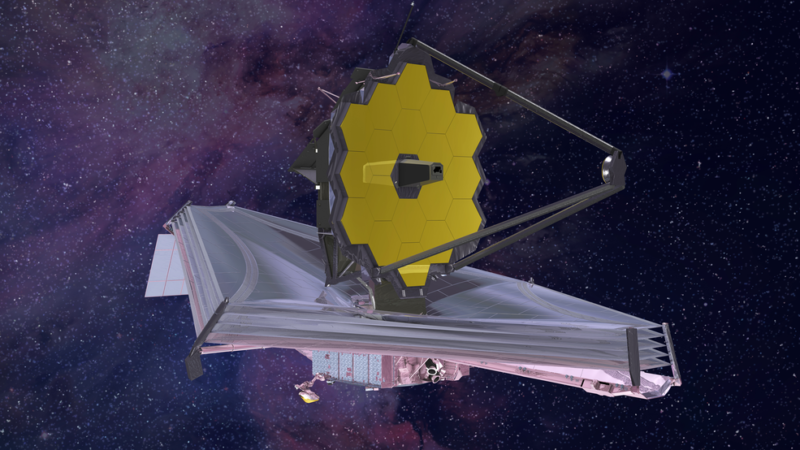
Data from the Webb Space Telescope has only gotten into the hands of astronomers over the last few weeks, but they've been waiting for years for this, and apparently had analyses set to go. The result has been something like a race back in time, as new discoveries find objects that formed ever closer to the Big Bang that produced our Universe. Last week, one of these searches turned up a galaxy that was present less than 400 million years after the Big Bang. This week, a new analysis has picked out a galaxy as it appeared only 233 million years after the Universe popped into existence.
The discovery is a happy byproduct of work that was designed to answer a more general question: How many galaxies should we expect to see at different time points after the Big Bang?
Back in time
As we mentioned last week, the early Universe was opaque to light at any wavelengths that carry more energy than is needed to ionize hydrogen. That energy is in the UV portion of the spectrum, but the red shift caused by 13 billion years of an expanding Universe has shifted that cutoff point into the infrared portion of the spectrum. To find galaxies from this time, we have to look for objects that aren't visible at shorter infrared wavelengths (meaning that light was once above the hydrogen cutoff), but do appear at lower-energy wavelengths.
The deeper into the infrared the boundary between invisible and visible is, the stronger the redshift, and the more distant the object is. The more distant the object, the closer in time it is to the Big Bang.
Studies of these galaxies can tell us something about their individual properties. But identifying a large collection of early galaxies can help us determine how quickly they formed and identify any changes in galaxy dynamics that happened at a specific time in the Universe's past. This change over time in the frequency of visible objects is called a "luminosity function," and some work has been done to characterize the luminosity function of early galaxies. But the infrared wavelengths of the earliest galaxies are absorbed by Earth's atmosphere, and so have to be imaged from space. And that was one of the design goals of the Webb Telescope.
The new work was focused on examining the luminosity function of galaxies that formed shortly (in astronomical terms) after the Big Bang. But, in generating a catalog of early galaxies, the researchers spot what appears to be the oldest galaxy ever imaged.
Defining the function
The researchers used two data sources to reconstruct the galaxies' appearances at different points in time. One was produced by analyzing work done with a ground-based infrared telescope (the ESA's VISTA telescope) and the Spitzer space telescope, both of which imaged galaxies that were relatively older when they produced the light that's now reaching Earth—about 600 million years or more after the Big Bang. The other involved data generated by the Webb, including those data sets analyzed in the paper we reported on and an area imaged in the first public photo release. In all cases, the researchers searched for the same thing: objects that were present at longer infrared wavelengths but absent from shorter ones.
Overall, the team identified 55 distant galaxies, 44 of which had never been noted previously. Thirty-nine of these come from the Webb data, and that figure included the two ancient galaxies that were identified last week. The numbers aren't especially precise at higher redshifts, where they're based on just one or two galaxies. But overall, the trend suggests a gradual decline in visible objects out to within a few hundred million years of the Big Bang, with no sharp changes or cutoffs.
But the striking thing is that there is data for a galaxy at an extremely large redshift (z = 16.7, for those who understand these things). That places it at less than 250 million years after the Big Bang. That distance is based partly on the fact that the first wavelength filter in which the object appears shows it to be very dim there, suggesting that it is faint at the wavelengths the filter lets through. That suggests that the light cutoff generated by hydrogen is near the edge of the filter's range.
Like the distant galaxies described last week, it also appears to have the equivalent of a billion Suns of material in the form of stars. The researchers estimate that it might have started star formation as early as 120 million years after the Big Bang, and had certainly done so by 220 million years.
The researchers are pretty confident that this new galaxy represents a real finding: "Having searched extensively, we are currently unable to find any plausible explanation for this object, other than a galaxy at a new redshift record." And by adding a second independent confirmation of the earlier galaxy finds, it greatly increases the confidence we have in those discoveries. All of which indicates the new telescope is delivering as promised, at least in terms of early galaxies.
The big question now is what will turn up when it's pointed at areas of high lensing, which might be able to magnify objects to a point where we can image structures within these early galaxies. It's possible that we've already done so, but we'll have to wait for the descriptions to show up on the arXiv.
The arXiv. Abstract number: 2207.12356 (About the arXiv).


3175x175(CURRENT).thumb.jpg.b05acc060982b36f5891ba728e6d953c.jpg)

Recommended Comments
There are no comments to display.
Join the conversation
You can post now and register later. If you have an account, sign in now to post with your account.
Note: Your post will require moderator approval before it will be visible.